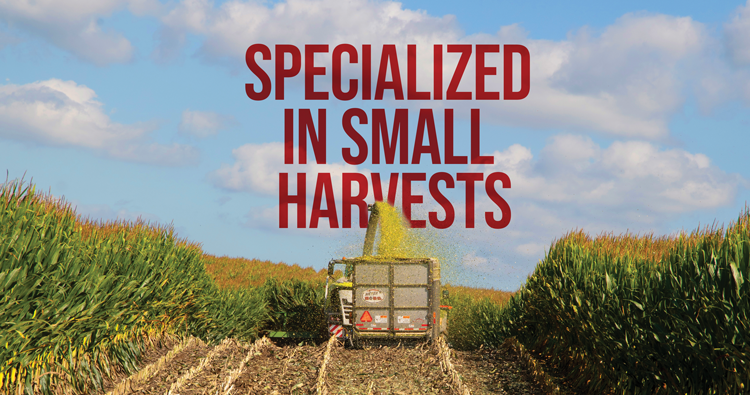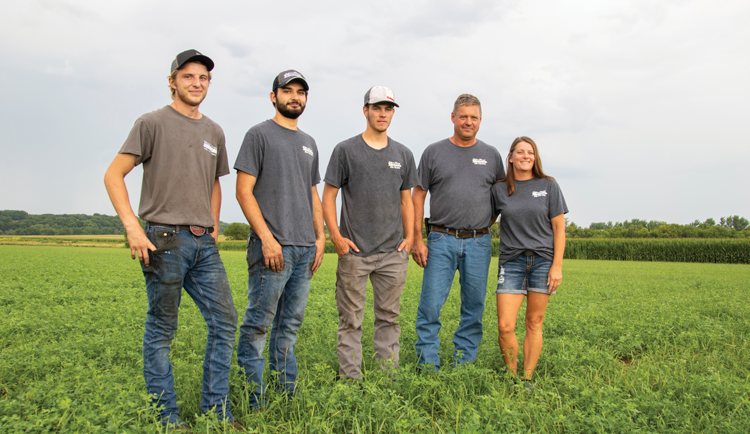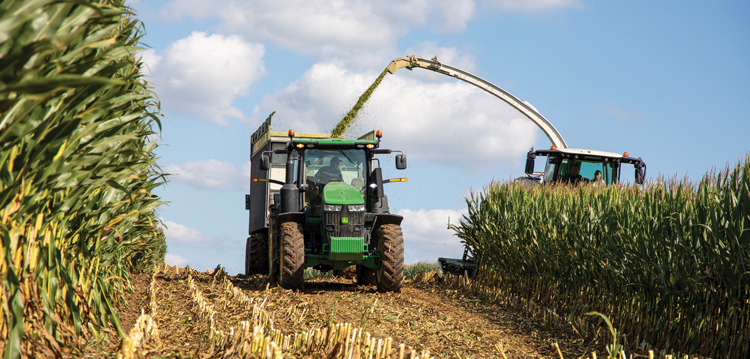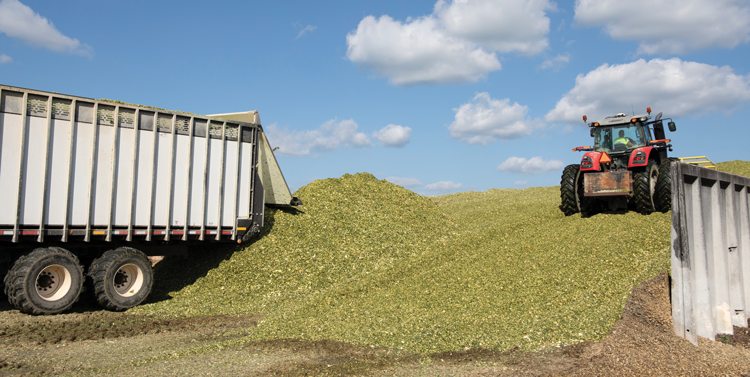Specialized in Small Harvests |
| By Amber Friedrichsen, Associate Editor |
|
|
|
The author served as the 2021 and 2022 Hay and Forage Grower summer editorial intern. She currently attends Iowa State University where she is majoring in agricultural communications and agronomy. 
When the summer sun sets over northwest Illinois, the crew members of Silver Streak Ag Services LLC cut their engines and climb down from their tractor cabs. Their job might not be done — in fact, it may have just been getting started — but they submit to their growling stomachs and pause for a paper plate meal in the middle of the field. This is a nightly tradition for John and Monica Osterhaus, owners of the custom forage harvesting business near Chadwick, Ill. Silver Streak Ag Services’ customer base spans from the Mississippi River to the outskirts of Aurora, and from the Wisconsin border to a half an hour south of Interstate 80. While their current radius paints a broad stripe across the top of the Prairie State, it started out as a dot on the map. John grew up on a farm in southwest Wisconsin and entered the workforce as a mechanic. He and Monica moved west when he pursued a job in the oil and gas industry and later relocated their family of five to Chadwick when John got a job on a pipeline. As they settled into their new life, the Osterhaus’ children attended a new school, made new friends, and got new jobs on a local dairy farm. Then one day, the farm’s owner asked for John’s help as well. “He approached me and said, ‘You need to buy a round baler so you can bale my hay,’” John recalled. “I thought about it, talked to a few other people nearby, and realized there was a need for more custom work. We officially started Silver Streak Ag Services in 2011, bought our first tractor and round baler, and I started baling hay part time.” After a couple of years, business was on a steady ascent. John sold the round baler and purchased a large square baler to meet customer demands, and he started receiving requests for custom chopping, too. He and Monica created a three-year plan to expand, but they didn’t want to move too fast. That is, until an irresistible opportunity fell into their laps. “In the winter of 2014, our biggest competition sold out. We decided this was our chance, and our three-year plan became a three-week plan. We bought a chopper, rented silage wagons, and hired out all of our hauling,” said the self-made businessman. “The next summer, we chopped about 700 acres of rye, hay, corn for silage, and corn earlage for eight or nine customers, and we thought we were really busy,” he laughed. Today, Silver Streak Ag Services has nearly 50 clients. John chops approximately 5,000 acres and makes up to 6,000 large square bales each year with the help of three full-time employees: Tim Schwank, Coby Snider, and Cody VanDyke. While they manage operations by day, Monica organizes harvest schedules, runs the business’ social media, and delivers dinner to their crew and their customers every night. Small-scale service Many of John’s clients are grain farmers who also raise beef cattle. The region’s rolling topography prevents them from growing row crops in some areas, so they plant forages and seed cover crops on hillsides and slopes to harvest for livestock feed. “The majority of our clientele are beef finishers or cow-calf producers,” John said. “A lot of the beef finishers want silage in their rations, but the cow-calf guys are our bread and butter. We chop more haylage and corn silage for cow-calf producers than anybody else in a given year.” Of the total acres John chops annually, about 1,000 are alfalfa haylage. Another 1,250 acres account for small grains like wheat, barley, and triticale, and the remaining acreage is an almost even split between corn silage and earlage. Despite these numbers, though, each job is relatively small. “Most of our chopping jobs are only 25- to 50-acre fields, but we do a lot of them,” John explained. “It’s not uncommon for us to be at three or four customers in one day. We start out at one place, chop 25 acres, move down the road and chop another 50 acres, and so on.” Because of this, communicating with clients is key to efficiency — especially when it comes to corn silage season. Some customers notify John when their corn is ready chop, whereas others trust him to scout their fields himself. One conversation about harvest sparks a chain reaction of calls. “It’s not uncommon for me to be on 40 to 50 phone calls a day during corn silage season, talking to clients about the maturity of their corn, determining when they are ready to chop, and figuring out our route,” John said. “We try not to jump all over the place. If I have one customer who calls saying they are ready to chop, I make three more phone calls to his neighbors to see if they are ready, too.” 
For full-service haylage jobs, the team runs a Pottinger triple mower, an Oxbo merger, and a Claas Jaguar 960. John owns several pull-type carts, and he regularly recruits some of his clients to haul silage. He also hires some of his customers who have pack tractors to help fill bunkers. “We have a laundry list of people we can contact, and if we are in a bind, I know I can call them to see if they can help,” he said. “Some of them might help one day a year, and some will help us for three weeks straight, but if we didn’t have them, we wouldn’t be able to do this.” John hires someone to bag silage, too, but he doesn’t have to rifle through his rolodex to find a farmer for this job. In addition to working for Silver Streak Ag Services, VanDyke manages his own bagging business. Not only does he bag silage for all of John’s customers, but he does custom work for other farmers as well. Big on baleage Silver Streak Ag Services also offers full-service baling. Soon after investing in a large square baler, John purchased an individual bale wrapper. Several of his clients prefer baleage in their rations, and since he is one of the only custom harvesters who bales large square bales in the area, he decided to be one of the few to wrap them, too. John wraps about 5,000 of the 6,000 bales he makes a year. He bales hay with a Hesston 4733 large square baler when forage is 35% to 45% moisture, but some producers ask for a drier product that is approximately 25% moisture, also known as “sweet hay.” Nonetheless, he enjoys making baleage more than dry hay because it offers more flexibility in production. 
“When we make baleage, I can schedule when I’m going to bale a day in advance,” he said. “We mow one day, and we bale the next. I love being able to work that way because I have a better idea of how my week is going to turn out.” Another factor of flexibility is that his clients with beef cattle aren’t necessarily concerned with forage quality; however, John also bales hay for a few dairy farms where this is a greater priority. In fact, one of his clients owns a goat dairy, and making baleage for these animals requires much more attention to detail. “On the goat dairy, we are shooting for what we call rocket fuel,” John asserted. “Goats have to have hay on the drier side because they have such small stomachs, and they thrive on baleage that has a relative feed value of 180 or more. We have done as many as seven cuttings a year here because it’s hard to achieve that level of quality unless you’re really pushing it.” Busy with repair Really pushing it translates to a lot of wear on harvest equipment. This is especially true of the chopper, but instead of following a set trade schedule, John replaces his machines when they reach a certain number of working hours. Rather than buy new, though, he purchases used choppers with minimal depreciation. “We look for used, low-hour, reliable equipment,” John said. “I would rather have something that is 10 years old with fewer hours but still does a good job, than a 2-year-old machine with a lot of hours that is constantly breaking down.” With that said, some breakdowns are inevitable, so John carries extra fuel filters and spare belts with him everywhere he goes. As a mechanic by trade, he does most machinery maintenance himself, but Schwank, Snider, and VanDyke also have backgrounds in mechanics and welding, and their expertise is essential in the shop as well. When he isn’t fixing his own fleet, John deals machinery for Meyer Manufacturing and Meyer’s Equipment Manufacturing. The former corporation produces box trucks, semitrailers, and bunk feeders, whereas the latter designs and develops manure spreaders. He and his team also fabricate box trucks and bale squeezes, and they take on various repair jobs for other farmers.  Corn silage is delivered to a client's bunker silo. Osterhaus has a ready list of people he can call on to help with packing. Mike Rankin Giving thanks Even though John spends a lot of time behind the wheel — and under the hood — he and Monica believe their clients are the ones steering the business. Instead of implementing their own ideas, they established Silver Streak Ag Services to be an adaptable enterprise and have scaled their level of service by making changes to meet customer expectations. To express their gratitude for their growth, the Osterhauses host a customer appreciation event every winter. John goes from controlling the chopper to manning the meat smoker, Monica prepares a smorgasbord of side dishes, and the couple welcome all of their customers to their home. They touch base with clients about the previous harvest and make plans for the upcoming season. More importantly, this annual gathering is an opportunity to strengthen the Silver Streak Ag Services community. “It’s our way of thanking our clients,” Monica smiled. “We want them to know we don’t take them for granted. We don’t have a single customer who is not a good customer, and we feel very fortunate for that.” This article appeared in the March 2023 issue of Hay & Forage Grower on pages 22-24. Not a subscriber? Click to get the print magazine. |
